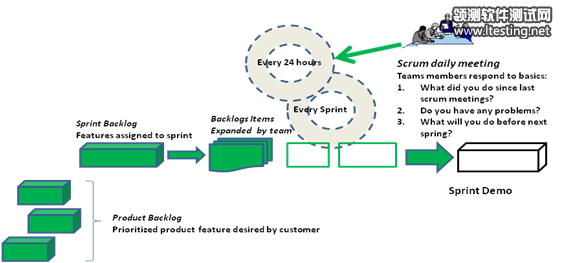Scrum的基本概念(英文)
1.1 What is Scrum?
Scrum is an iterative, incremental process for developing any product or managing any work. It produces a potentially shippable set of functionality at the end of every iteration. It's attributes are:
· Scrum is an agile process to manage and control development work.
· Scrum is a wrapper for existing engineering practices.
· Scrum is a team-based approach to iteratively, incrementally develop systems and products when requirements are rapidly changing
· Scrum is a process that controls the chaos of conflicting interests and needs.
· Scrum is a way to improve communications and maximize co-operation.
· Scrum is a way to detect and cause the removal of anything that gets in the way of developing and delivering products.
· Scrum is a way to maximize productivity.
· Scrum is scalable from single projects to entire organizations. Scrum has controlled and organized development and implementation for multiple interrelated products and projects with over a thousand developers and implementers.
· Scrum is a way for everyone to feel good about their job, their contributions, and that they have done the very best they possibly could.
1.2 Scrum Rules
Backlog: a prioritized list of all work to be completed prior to releasing a product:
· Only one person maintains and prioritizes the backlog list.
· Any interested party can request that backlog be put on the list.
Between sprints, all involved parties and the engineering team meet to determine which work can be completed in the next sprint, and what the executable will be.
Sprint: a short burst of work lasting approximately 30 days during which an executable and other deliverables are built by an engineering team, as indicated by the assigned backlog.
· A sprint lasts no more than 30 days.
· A sprint is undertaken by a cross functional team consisting of no more than 9 members.
· Every sprint has a specific goal.
· An executable demonstrating the goal will be completed by the team during the sprint.
· The sprint team has final say in estimating and determining what they can accomplish during the sprint.
· Once the sprint is underway, new backlog cannot be added to the sprint except that, if the scrum master determines that a new backlog item will enhance the viability of the product, is in alignment with the sprint, builds on the sprint’s executable, and can be completed within the sprint’s time frame, the backlog item can be added. Examples are building a demonstration of the executable for a specific purpose, such as a trade show or prospect.
· If external forces determine that the sprint is working on the wrong thing, a sprint can be halted and restarted with new backlog and purpose.
Scrum Meeting: A short daily meeting where the team shares status.
· During the sprint, the team conducts daily scrum meetings.
· The meetings are held in the same place at the same time every work day.
· The meetings don’t last for more than 30 minutes.
· A scrum master is appointed.
· The scrum master is responsible for asking every team member the following three questions:
v What have you done since the last scrum meeting?
v What has impeded your work?
v What do you plan on doing between now and the next scrum meeting?
· Conversation is restricted to the team members answering the above questions.
· Meetings can be established for immediately after the scrum meeting based on answers to the above questions.
· The scrum master is responsible for making decisions immediately, if required to remove impediments to progress.
· The scrum master is responsible for noting impediments that must be resolved external to the meeting and causing them to be removed.
1.3 Scrum Process
On the first day of the every sprint all RDs will have one Development meeting. In this meeting some issues will be picked up as the backlogs. This backlog will be completed in the sprint. Once those backlogs are ensured, nobody can add additional backlogs to this sprint.
Every day daily scrum meeting will be held and every team member will talk about the yesterday’s working. Three main questions will be expressed: Firstly, you have finished working since the last scrum meeting; Secondly, you have encountered some problems. Thirdly, you will do something in the next day.

原文转自:http://www.cnblogs.com/Tcorner/archive/2009/08/03/Scrum.html





